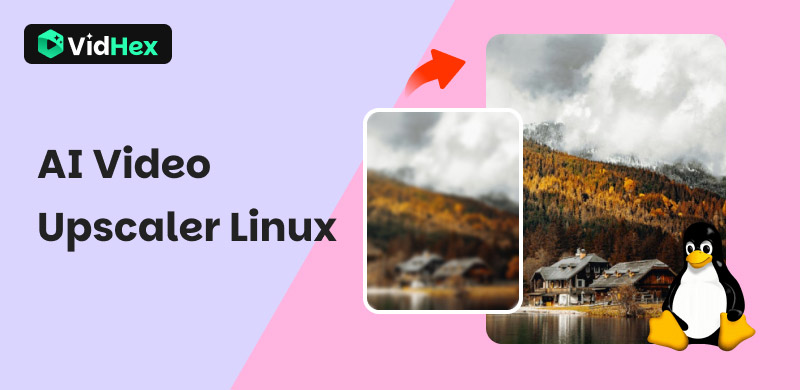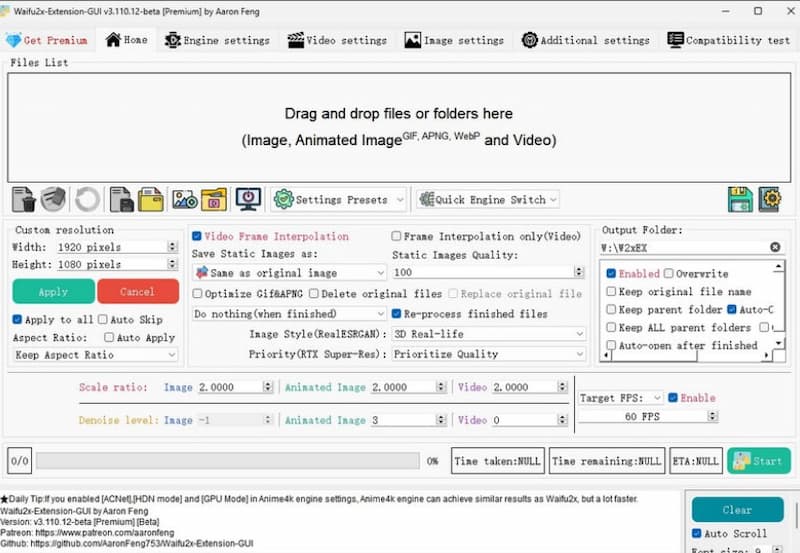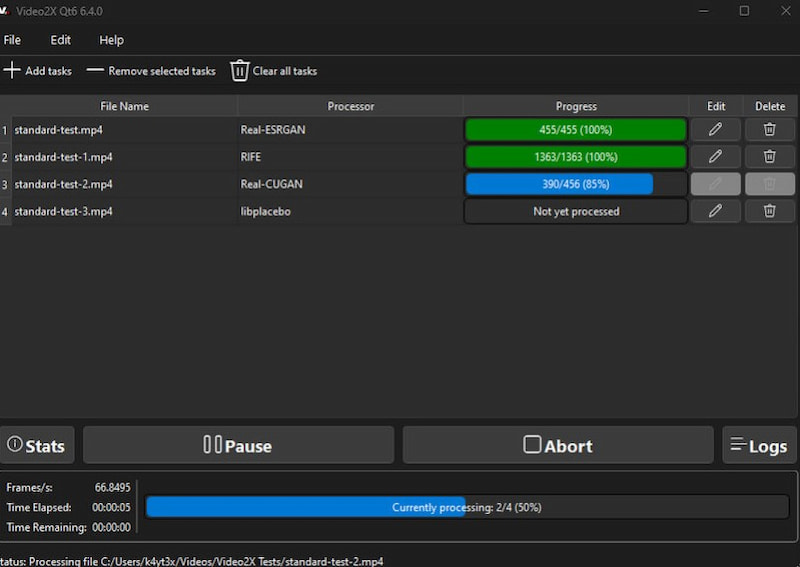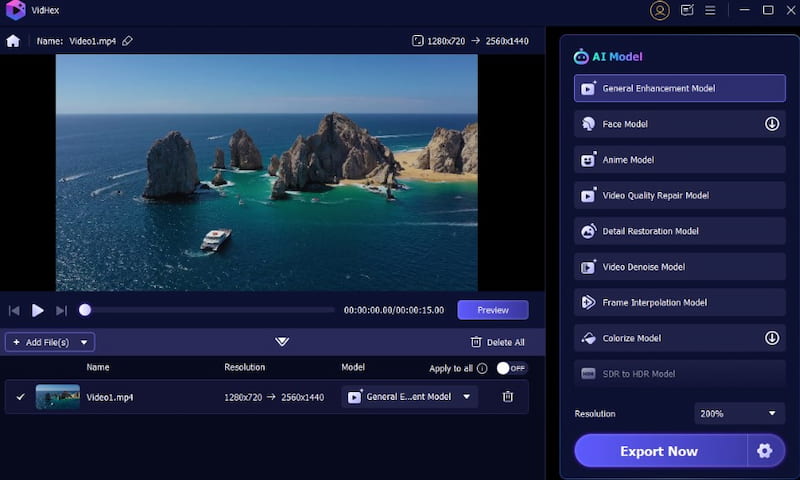Leading AI Video Upscaling Tools for Your Linux Computers
Numerous open-source tools promise to upscale or enhance video using artificial intelligence. Some are designed by researchers and maintained by GitHub contributors, while individual developers fine-tune others for practical everyday use. Here are some of the most popular free open-source video upscalers and enhancers that users frequently use. Each has unique strengths, limits, and peculiarities that you should be aware of before jumping in. See the top three AI Upscalers for Linux now!

Contents:
How We Test These Video Upscalers for Linux
When we are reviewing video upscalers for Linux, we prioritize accuracy, performance, and usability. Each instrument is carefully tested to guarantee it meets practical requirements. Here's how we tested and determined which upscalers produced the greatest results.
Image Quality Check
We compare before and after frames to assess sharpness, feature preservation, and artifact reduction.
Performance benchmarking
Processing speed, hardware use, and system stability are all tested across many configurations.
Review the user experience.We evaluate ease of installation, interface design, and compatibility with popular Linux distributions.
Part 1. Quick Comparison of 3 Best Video Upscalers for Linux
| Tool | Quality | Speed | Hardware | Ease of Use | Best Use |
|---|---|---|---|---|---|
| Waifu2x-Extension GUI | Great for anime/cartoon, supports many engines | Fast with GPU, varies by engine | Needs decent GPU (NVIDIA/AMD/Intel) | GUI, presets, user-friendly | Anime/cartoons, quick upscaling |
| Real-RSRGAN (Real-ESRGAN) | Best for real-life videos, strong detail recovery | Slower with large models, tiling helps | High GPU memory needed | Mostly command line, advanced tuning | Real-world videos, detail restoration |
| Video2x | Flexible, supports anime & real-life | Depends on pipeline, newer builds faster | GPU strongly recommended, multi-GPU helps | Technical setup, customizable | All-around, versatile upscaling |
Part 2. Waifu2x Extension Gui
Waifu2x Extension GUI is a simple, Windows-only desktop application that integrates multiple AI upscalers, including waifu2x, Real-ESRGAN, and Anime4K, into a single graphical interface. Originally intended for anime-style photographs and films, it has now been modified to include real-world content, including extra model possibilities. It's well-known for being simple to install and operate, with no command-line actions necessary.
Steps to Use Waifu2x
Step 1. Run the installation. Once completed, launch the application using the desktop shortcut or the Start Menu.
Step 2. Drag and drop your video file into the software, or click Add Files and choose an input.
Step 3. Select an AI model now. Then, set the output resolution multiplier. As an optional step, you can also apply denoising, frame interpolation, or artifact reduction.
Step 4. Click the Start button. The program will do everything automatically, including frame extraction, upscaling, video rebuilding, and audio synchronization.

Pros
- There are built-in video/audio muxing capabilities.
- Experienced users can take advantage of batch processing and complex settings.
- No Python or external dependencies are required.
Cons
- Processing can be time-consuming on low-end GPUs.
- Model selections and update frequency are dependent on developer maintenance.
- A little heavier installation.
Part 3. Real-Esrgan
Real-ESRGAN is another popular free open-source AI image and video upscaler built by the same team that created ESRGAN. It is based on the PyTorch framework and provides high-quality picture and video upscaling with pre-trained generative adversarial networks or GANs. Although it was created for single-image super-resolution, Real-ESRGAN may also be used to process film frame by frame, making it an excellent alternative for recovering low-resolution or compressed video information.
It works particularly well on real-world scenes, such as landscapes, faces, or low-quality smartphone footage, and is noted for its ability to restore fine details while minimizing noise and compression artifacts.
Steps in Using Real-Esrgan
Step 1. First, we need to prepare your video. Run FFmpeg to extract frames from your video.
ffmpeg -i input.mp4 frames/frame_%08d.png
Step 2. Upscale the video: Use Real-ESRGAN to improve the extracted frames. For 4x upscaling, use:
python inference_realesrgan.py -n RealESRGAN_x4plus -i frames --outscale 4
Step 3. Recombine the frames: Once upscaled, use FFmpeg to convert the frames back into a video:
python inference_realesrgan.py -n RealESRGAN_x4plus -i frames --outscale 4
Step 4. As an additional step, you can add the audio. To restore the original audio, run:
ffmpeg -i upscaled.mp4 -i input.mp4 -c copy -map 0:v:0 -map 1:a:0 final_output.mp4
Pros
- Superior image enhancement quality, particularly for real-world photos and movies.
- Multiple pre-trained models are available.
- Actively maintained and supported by a robust research team.
- Can be written or incorporated into custom video workflows.
Cons
- There is no built-in GUI; thus, you must use the command line or manually script it.
- Frame extraction and recombination are required for video utilization.
- Requires a Python environment and minimal knowledge of PyTorch.
- CPU processing can be slow; for real applications, a GPU is highly recommended.
Part 4. Video2x
Video2X is a popular open-source video upscaler that works by extracting individual frames, enlarging them with AI-powered picture upscalers, and then rebuilding a high-resolution movie from those processed frames.
The method includes numerous stages:
• Frame Extraction: First, Video2X splits the video into individual frames and an audio file using FFmpeg.
• Frame Upscaling: Each frame is then upscaled using one of the available AI models, such as waifu2x, SRMD, or Anime4KCPP. The upscaling models are adjustable, allowing users to select the one that best matches the genre of content (for example, anime versus real-life footage).
• Video Reconstruction: After processing the frames, FFmpeg reassembles the upscaled frames and original audio to create a final high-resolution video.
The procedure can be slow, especially when processing large videos or when GPU acceleration is unavailable.
Step 1. Build the project. To prepare your machine, refer to the official Video2X build guides for Windows and Linux.
Step 2. et the most recent release from GitHub, or install the Qt6 GUI version for simpler use.
Step 3. Check the criteria. Make sure your CPU supports AVX2 and your GPU supports Vulkan.
Step 4. Run the application. Open Video2X, load your video, select an AI model such as RealESRGAN, establish options, and begin upscaling.

Pros
- Supports several AI backends to accommodate various sorts of material.
- Provides a Windows GUI that is easy to use for non-technical users.
- Batch processing is available for long films and entire folders.
- It is free and open-source, with no feature limits or watermarks.
Cons
- Processing is slow without GPU acceleration; an NVIDIA GPU is strongly recommended.
- Audio is not handled simultaneously with video and must be reattached individually.
- Installation and model configuration can be difficult for novices.
- Linux support is limited and requires manual configuration.
- This tool does not run natively on macOS.
Part 5. Bonus: The Best AI Video Upscaler for Windows/Mac
If you're working on systems other than Linux, the VidHex Video Upscaler is an excellent all-in-one solution for Windows and Mac. It streamlines the entire upscaling process with a straightforward interface and advanced AI algorithms. Unlike most open-source solutions that need technical processes, VidHex provides one-click enhancement without the need to extract frames or use command lines. You may submit any video, old footage, grainy clips, or low-resolution files- and it will quickly be upscaled to 4K with realistic detail retention.

Key Feature
• User-friendly and fully automated upscaling
• Supports 2x, 4x, and even 8x upscaling, with excellent detail recovery.
• AI-based noise and blur reduction
• Works perfectly on both Windows and macOS.
Conclusion
Linux users have access to strong AI video-enhancing tools such as Waifu2x Extension GUI, Real-ESRGAN, and Video2x. Depending on your hardware and experience level, each caters to a distinct set of requirements, ranging from anime-style images to realistic restoration. VidHex provides a quality and easy-to-use experience for individuals looking for a simple yet powerful alternative to Linux. Whether open-source or commercial, the key is to select the upscaler that best suits your workflow and video objectives.




